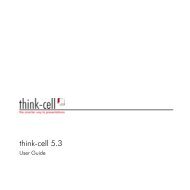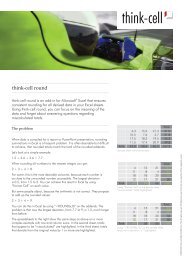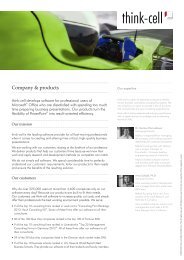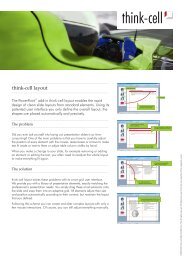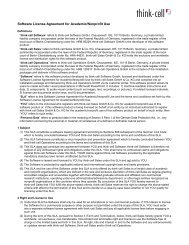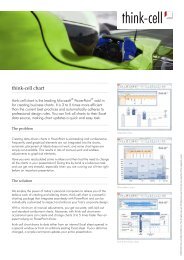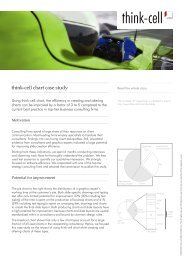think-cell technical report TC2003/01 A GUI-based Interaction ...
think-cell technical report TC2003/01 A GUI-based Interaction ...
think-cell technical report TC2003/01 A GUI-based Interaction ...
Create successful ePaper yourself
Turn your PDF publications into a flip-book with our unique Google optimized e-Paper software.
4.2 <strong>Interaction</strong> Toolbox INTERACTION CONCEPT<br />
and modifying elements. However, I expect that a future version of the <strong>think</strong>-<strong>cell</strong><br />
software, if <strong>based</strong> on ongoing user studies, will implement more intuitive and less<br />
interaction-intensive interaction patterns for the same tasks.<br />
4.2.6 Feedback to the User<br />
Besides input from the user, feedback to the user is the other component in human-<br />
computer interaction. The challenge of providing good feedback is to give exactly<br />
the information required for the user’s task, to prioritize that information to prevent<br />
information overload on the user’s part, and to render the information such that it<br />
gets as much of the user’s attention as required without unnecessarily distracting<br />
the user from her main task.<br />
Although in theory input from the computer to the human could use any of the<br />
five senses, the only feedback devices available on a standard personal computer<br />
are the screen and the speaker. Yet, for the present application I refrain from<br />
using audio as a feedback channel, because my study showed that the target user<br />
group works in open-plan offices (Sect. 2.1.2). In this situation, audio feedback from<br />
various workplaces that are located next to each other would do more harm than<br />
good. In effect, the only feedback channel available for my application is the screen.<br />
The focus of the application is semiautomatic layout <strong>based</strong> on implicitly specified<br />
constraints. Hence, I must provide enough feedback for the user to understand why<br />
a certain layout was chosen and which constraints must be added, removed, or<br />
changed in order to achieve the desired layout. The visualization of constraints and<br />
their impact on the result plays an important role for the learnability, robustness<br />
and efficiency of the system: The user must understand the input-result-relation<br />
to make appropriate use of the layout tool. Moreover, some kind of preview that<br />
explains what would happen if, for instance, the mouse button was clicked in a<br />
certain position, together with instant feedback on user actions, helps the user to<br />
avoid or at least to notice erroneous input and to learn the optimal interaction<br />
patterns.<br />
It might be interesting to incorporate some animation to explain layout changes.<br />
In research, animation has been successfully applied in similar settings, where state<br />
transitions would otherwise be obscure to the user (e. g., [Gle92]). However, ani-<br />
mation requires extra efforts in terms of programming and runtime resources, and<br />
it very strongly attracts attention, distracting from anything else the user might<br />
be doing. For these reasons, animation must be used with care and I did not use<br />
animation at all in the present prototype.<br />
Other uses of feedback are understood in recent office software and should be<br />
continued in my application. For example, the 3-dimensional appearance of a but-<br />
ton conveys the affordance to push it. The shape changes on mouse-over to confirm<br />
its responsiveness and on button-click to acknowledge the recognition of a com-<br />
mand. Another example is the mouse pointer shape that reflects system state (an<br />
hourglass when the system is temporarily not responsive) and input modes (a cross<br />
hair for inserting new objects into a slide). The mouse pointer shape is especially<br />
51



